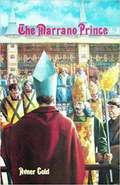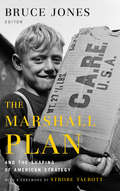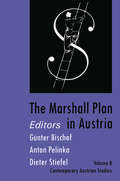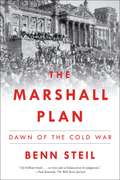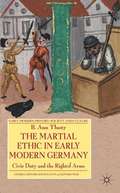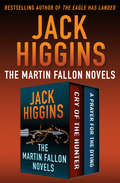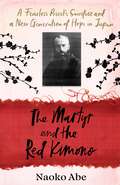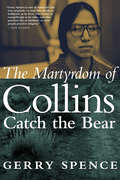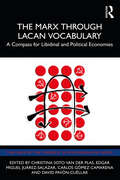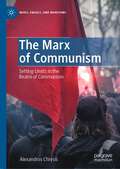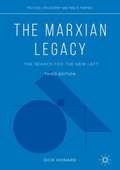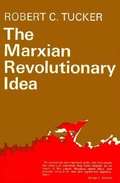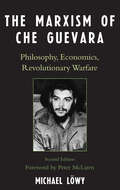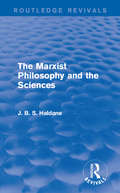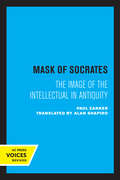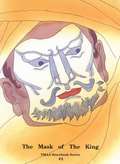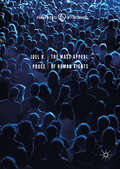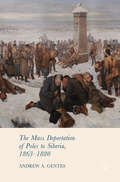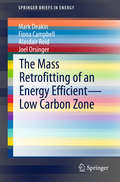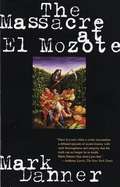- Table View
- List View
The Marrano Prince (Ruach Ami #8)
by Avner GoldThe Marrano Prince, the eighth volume in the continuing Ruach Ami Series, takes place and Spain two centuries after the establishment of the Spanish Inquisition and the Expulsion of the Jews. Deprived of the talents of its Jews, Spain has gone into steep decline, and France and England have emerged as dominant powers in Europe. As the story unfolds, Spain and France are on the verge of a war in the Netherlands. A minister of the Council of State, who is also a secret Jew, is sent on a high-level diplomatic mission to the Netherlands, which turns into an unforeseen journey of discovery. When he finally returns to Spain, he finds his family has fallen under a cloud of suspicion, but before he can escape with his family he feels honor-bound to fulfill his duties to the king. In the meantime, he is being silently stalked by the evil confessor of the king and his minions in the Holy Office of the Inquisition. Before he realizes what is happening, a net of entrapment has closed around him. Danger and a sense of foreboding purveyed the pages of the gripping book. The story moves inexorably through the halls of power in Madrid, naval battles on the high seas, the marrano community of Amsterdam, the dungeons of the Inquisition in Toledo, the bullfights of Pamplona and across the length and breath of sun-drenched Spain. It is a story of courage and valor, of twists within twists peopled with colorful villains and heroes. In his inimitable fashion, Avner Gold has woven a great deal of historical information and a sense of the times into the fabric of the story itself. However, an extensive historical essay, entitled The Rise and Fall of Spain and It's Jews, has also been added to this book for the benefit of those readers who would like a better understanding of the evolution of the Jewish community of Spain and the origins and methods of the infamous Spanish Inquisition.
The Marriott Cell: An Epic Journey from Cairo's Scorpion Prison to Freedom
by Carol Shaben Amal Clooney Mohamed FahmyAward-winning journalist Mohamed Fahmy's widely anticipated account of his wrongful incarceration in Cairo's maximum-security Scorpion Prison for terrorists and political leaders, and his subsequent battle for justice, opens a remarkable window onto the closed world of Islamic fundamentalism and the bloody geopolitical struggles that dominate our headlines. An important book that reads like a political thriller, it is also a testament to the critical importance of journalism today; an inspiring love story that made front-page news; and a profoundly personal drama of one man's fight for freedom. On the night of December 29, 2013, Egyptian security forces, in a dramatic raid on the Marriott Hotel, seized Fahmy (Canadian-Egyptian Bureau Chief for Al Jazeera English) and two of his colleagues, Peter Greste and Baher Mohamed, accusing them of fabricating news as members of the outlawed Muslim Brotherhood. Their trials became a global cause célèbre condemned as a travesty. But Fahmy also never stopped being a journalist: inside Scorpion he found himself cheek by jowl with notorious Muslim Brotherhood leaders, Al Qaeda fighters, and ISIS sympathizers. Always intrepid, he took advantage of the situation to "interview" the Brotherhood about their aims, gaining exclusive insight into the geopolitical feuds between Egypt, Saudi Arabia, and the UAE on one hand and Qatar and its allies, including Turkey on the other--interviews that led him to sue his former employer, Al Jazeera, from prison. The complex power brokering of Middle Eastern and Western governments left three men trapped in a web he describes as "Global McCarthyism." But at the heart of the book is an inspiring story of two strong women: Fahmy's wife, Marwa Omara, who used every means possible to fight for his release, bravely risking her safety; and his courageous international human-rights lawyer, Amal Clooney, who championed his battle for freedom.From the Hardcover edition.
The Marrying Kind?: Debating Same-Sex Marriage within the Lesbian and Gay Movement
by Mary Bernstein and Verta TaylorAs the fight for same-sex marriage rages across the United States and lesbian and gay couples rush to marriage license counters, the goal of marriage is still fiercely questioned within the LGBT movement. Rarely has an objective so central to a social movement&’s political agenda been so controversial within the movement itself. While antigay forces work to restrict marriage to one man and one woman, lesbian and gay activists are passionately arguing about the desirability, viability, and social consequences of same-sex marriage. The Marrying Kind? is the first book to draw on empirical research to examine these debates and how they are affecting marriage equality campaigns. The essays in this volume analyze the rhetoric, strategies, and makeup of the LGBT social movement organizations pushing for same-sex marriage, and address the dire predictions of some LGBT commentators that same-sex marriage will spell the end of queer identity and community. Case studies from California, Connecticut, Massachusetts, New Jersey, Oklahoma, Vermont, and Canada illuminate the complicated politics of same-sex marriage, making clear that the current disagreements among LGBT activists over whether marriage is conforming or transformative are far too simplistic. Instead, the impact of the marriage equality movement is complex and often contradictory, neither fully assimilationist nor fully oppositional. Contributors: Ellen Ann Andersen, U of Vermont; Mary C. Burke, U of Vermont; Adam Isaiah Green, U of Toronto; Melanie Heath, McMaster U, Ontario; Kathleen E. Hull, U of Minnesota; Katrina Kimport, U of California, San Francisco; Jeffrey Kosbie; Katie Oliviero, U of Colorado, Boulder; Kristine A. Olsen; Timothy A. Ortyl; Arlene Stein, Rutgers U; Amy L. Stone, Trinity U; Nella Van Dyke, U of California, Merced.
The Marshall Plan and the Shaping of American Strategy
by Strobe Talbott Bruce D. Jones Will MorelandHow the United States helped restore a Europe battered by World War II and created the foundation for the postwar international orderSeventy years ago, in the wake of World War II, the United States did something almost unprecedented in world history: It launched and paid for an economic aid plan to restore a continent reeling from war. The European Recovery Plan-better known as the Marshall Plan, after chief advocate Secretary of State George C. Marshall-was in part an act of charity but primarily an act of self-interest, intended to prevent postwar Western Europe from succumbing to communism. By speeding the recovery of Europe and establishing the basis for NATO and diplomatic alliances that endure to this day, it became one of the most successful U.S. government programs ever.The Brookings Institution played an important role in the adoption of the Marshall Plan. At the request of Arthur Vandenberg, chairman of the Senate Foreign Relations Committee, Brookings scholars analyzed the plan, including the specifics of how it could be implemented. Their report gave Vandenberg the information he needed to shepherd the plan through a Republican-dominated Congress in a presidential election year.In his foreword to this book, Brookings president Strobe Talbott reviews the global context in which the Truman administration pushed the Marshall Plan through Congress, as well as Brookings' role in that process. The book includes Marshall's landmark speech at Harvard University in June 1947 laying out the rationale for the European aid program, the full text of the report from Brookings analyzing the plan, and the lecture Marshall gave upon receiving the Nobel Peace Prize in 1953. The book concludes with an essay by Bruce Jones and Will Moreland that demonstrates how the Marshall Plan helped shape the entire postwar era and how today's leaders can learn from the plan's challenges and successes.
The Marshall Plan in Austria: Vol 8 (Contemporary Austrian Studies #Vol. 8)
by Günter Bischof, Anton Pelinka and Dieter StiefelPerhaps no country benefitted more from the Marshall Plan for assistance in reconstruction of Europe after World War II than Austria. On a per capita basis, each American taxpayer invested $80 per person in the Plan; each Austrian received $133 from the European recovery program, more than any other of the sixteen participating countries. Without the Marshall Plan, the Austrian economic miracle of the 1950s would have been unthinkable. Despite this, contemporary Austria seems to have forgotten this essential American contribution to its postwar reconstruction. This volume in the Contemporary Austrian Studies series examines how the plan affected Austria, and how it is perceived today.The political context of the Marshall Plan in Austria is addressed in essays by Jill Lewis and Matthew Berg. Dieter Stiefer describes the vast Soviet economic exploitation of their Austrian occupation zone. Andrea Komlosy shows how the Marshall Plan helped complete the division of Europe. Siegfried Beer suggests the secret involvement of the CIA in the Marshall Plan, while Hans J³rgen Schr÷der analyzes the effectiveness of Marshall Plan propaganda programs in Germany and Austria.The macroeconomic impact of Marshall Plan funds on Austrian economic policy is outlined by Hans Seidel. Kurt Tweraser, Georg Rigele and G³nter Bischof suggest the microeconomic importance of funds for the steel, electricity and tourist sectors of the Austrian economy. Wilhelm Kohler's sweeping analysis compares the American transfer of funds to postwar Europe with current debates about the cost of European Union enlargement. The legacy of the Marshall Plan is addressed by former Austrian Finance Minister Ferdinand Lacina. Kurt Loffler and Hans Fubenegger summarize the activities of the Economic Recovery Program Fund. Coming on the heels of the fiftieth anniversary of the Marshall Plan, this compelling overview of the Plan and its impact will be important for historians, those interested in international politics, and Austrian scholars.G³nter Bischof is professor of history and associate director of Center-Austria at the University of New Orleans; Anton Pelinka is professor of political science at the University of Innsbruck and director of the Institute of Conflict Research in Vienna; Dieter Stiefel is professor of social and economic history at the University of Vienna and executive secretary of the Schumpeter Society in Vienna.This volume offers a collection of articles, mostly by contemporary Austrian-born historians, touching on various phases of the Marshall Plan administered through the European Recovery Program (ERP) and its successors counterfunds' assistance to the present. A splendid introduction followed by the key thirteen articles on the plan is augmented by several nontopical essays and book reviews, along with a survey of Austrian politics in 1998. A number of articles emanated from a 1998 conference at the University of New Orleans. Both novice and specialist will appreciate this book."-The Historian
The Marshall Plan: Dawn of the Cold War
by Benn SteilWinner of the 2019 New-York Historical Society Barbara and David Zalaznick Book Prize in American History Winner of the 2018 American Academy of Diplomacy Douglas Dillon Award Shortlisted for the 2018 Duff Cooper Prize in Literary Nonfiction Honorable Mention (runner-up) for the 2019 ASEEES Marshall D. Shulman Prize &“[A] brilliant book…by far the best study yet&” (Paul Kennedy, The Wall Street Journal) of the gripping history behind the Marshall Plan and its long-lasting influence on our world.In the wake of World War II, with Britain&’s empire collapsing and Stalin&’s on the rise, US officials under new Secretary of State George C. Marshall set out to reconstruct western Europe as a bulwark against communist authoritarianism. Their massive, costly, and ambitious undertaking would confront Europeans and Americans alike with a vision at odds with their history and self-conceptions. In the process, they would drive the creation of NATO, the European Union, and a Western identity that continue to shape world events. Benn Steil&’s &“thoroughly researched and well-written account&” (USA TODAY) tells the story behind the birth of the Cold War, told with verve, insight, and resonance for today. Focusing on the critical years 1947 to 1949, Benn Steil&’s gripping narrative takes us through the seminal episodes marking the collapse of postwar US-Soviet relations—the Prague coup, the Berlin blockade, and the division of Germany. In each case, Stalin&’s determination to crush the Marshall Plan and undermine American power in Europe is vividly portrayed. Bringing to bear fascinating new material from American, Russian, German, and other European archives, Steil&’s account will forever change how we see the Marshall Plan. &“Trenchant and timely…an ambitious, deeply researched narrative that…provides a fresh perspective on the coming Cold War&” (The New York Times Book Review), The Marshall Plan is a polished and masterly work of historical narrative. An instant classic of Cold War literature, it &“is a gripping, complex, and critically important story that is told with clarity and precision&” (The Christian Science Monitor).
The Martial Ethic in Early Modern Germany
by B. Ann TlustyFor German townsmen, life during the sixteenth and seventeenth centuries was characterized by a culture of arms, with urban citizenry representing the armed power of the state. This book investigates how men were socialized to the martial ethic from all sides, and how masculine identity was confirmed with blades and guns.
The Martin Fallon Novels: Cry of the Hunter and A Prayer for the Dying (The Martin Fallon Novels)
by Jack HigginsFrom the New York Times–bestselling author of The Eagle Has Landed: An IRA hit man tries to walk the razor&’s edge when he finds himself the odd man out. In these edge-of-your-seat international thrillers, Jack Higgins introduces his profoundly conflicted and deeply flawed IRA hero, Martin Fallon, trapped in a life of violence and fighting for redemption. Cry of the Hunter: After joining the IRA, Martin Fallon shot up the ranks in the fight against the Brits in Northern Ireland with his tactical brilliance and fierce commitment. Then, after a daring escape from prison, he simply disappeared. After years of hiding from the world in his books and the bottle, he thinks he&’s out. He&’s wrong. The IRA wants him to break a high-ranking Ulster rebel out of prison. Fallon reluctantly agrees, but soon finds that in his absence, the IRA has changed. Those who wanted freedom have been replaced by bloodthirsty psychopaths who only crave power. Now, to save the country he loves, Fallon must turn on his own people. A Prayer for the Dying: There was a time when Martin Fallon had no problem killing for his IRA brethren, without remorse or regret. But when a mistake leads to the explosion of a school bus full of children, Fallon flees to London to hide with his guilt. His seclusion is broken when he agrees to make one last killing on behalf of the criminal Meehan brothers. But when the hit is witnessed by a priest, the Meehans want the clergyman dead too. In a desperate struggle for his soul, Fallon must protect the priest by fighting the ruthless Meehans as well as his former IRA comrades, who have decided that Fallon himself needs to be silenced. Made into a film starring Mickey Rourke as Fallon, A Prayer for the Dying is a &“tough . . . superbly written&” thriller (The New York Times Book Review).
The Martyr and the Red Kimono: A Fearless Priest’s Sacrifice and A New Generation of Hope in Japan
by Naoko AbeThe remarkable true story of Saint Maximilian Kolbe, and the two men in war-torn Japan whose lives he changed forever.On the 14th of August 1941, a Polish priest named Maximilian Maria Kolbe was murdered in Auschwitz.Kolbe's life had been remarkable. Fiercely intelligent and driven, he founded a movement of Catholicism and spent several years in Nagasaki, ministering to the 'hidden Christians' who had emerged after centuries of oppression. A Polish nationalist as well as a priest, he gave sanctuary to fleeing refugees and ran Poland's largest publishing operation, drawing the wrath of the Nazis. His death was no less remarkable: he volunteered to die, saving the life of a fellow prisoner.It was an act that profoundly transformed the lives of two Japanese men. Tomei Ozaki was just seventeen when the US dropped an atomic bomb on Nagasaki, destroying his home and his family. Masatoshi Asari worked on a farm in Hokkaido during the war and was haunted by the inhumane treatment of prisoners in a nearby camp. Forged in the crucible of an unforgiving war, both men drew inspiration from Kolbe's sacrifice, dedicating their lives to humanity and justice. Ozaki followed in his footsteps and became a friar. Asari created cherry trees as peace offerings.In The Martyr and the Red Kimono, award-winning author Naoko Abe weaves together a deeply moving and inspirational true story of resistance, sacrifice, guilt and atonement.
The Martyrdom of Collins Catch the Bear
by Gerry SpenceThe search for justice for a Lakota Sioux man wrongfully charged with murder, told here for the first time by his trial lawyer, Gerry Spence. This is the untold story of Collins Catch the Bear, a Lakota Sioux, who was wrongfully charged with the murder of a white man in 1982 at Russell Means&’s Yellow Thunder Camp, an AIM encampment in the Black Hills in South Dakota. Though Collins was innocent, he took the fall for the actual killer, a man placed in the camp with the intention of compromising the reputation of AIM. This story reveals the struggle of the American Indian people in their attempt to survive in a white world, on land that was stolen from them. We live with Collins and see the beauty that was his, but that was lost over the course of his short lifetime. Today justice still struggles to be heard, not only in this case but many like it in the American Indian nations.
The Marx Through Lacan Vocabulary: A Compass for Libidinal and Political Economies
by Christina Soto van der Plas, Edgar Miguel Juárez-Salazar, Carlos Gómez Camarena and David Pavón-CuéllarThis text explores a set of key concepts in Marxist theory as developed and read by Lacan, demonstrating links and connections between Marxist thought and Lacanian practice. The book examines the complexity of these encounters through the structure of a comprehensive vocabulary which covers diverse areas, from capitalism and communism to history, ideology, politics, work, and family. Offering new perspectives on these concepts in psychoanalysis, as well as in the fields of political and critical theory, the book brings together contributions from a range of international experts to demonstrate the dynamic relationship between Marx and Lacan, as well as illuminating "untranslatable points" which may offer productive tension between the two. The entries trace the trajectory of Lacan’s appropriation of Marx’s concepts and analyses how they were questioned, criticized, and reworked by Lacan, accounting for the wide reach of two thinkers and worlds in constant homology. Each entry also discusses psychoanalytic debates relating to the concept and seeks to refine the clinical scope of Marx’s work, demonstrating its impact on the social and individual dimensions of Lacanian clinical practice. With a practical and structured approach, The Marx through Lacan Vocabulary will appeal to psychoanalysts and researchers in a range of fields, including political science, cultural studies, and philosophy.
The Marx of Communism: Setting Limits in the Realm of Communism (Marx, Engels, and Marxisms)
by Alexandros ChrysisFollowing Marx’s own itinerary from Paris to London, from politics to the critique of political economy, The Marx of Communism delves into a creatively unfolding international debate on the democracy-communism relation, while supporting a 21st century communism as a social alternative to capitalism. Taking into consideration Marx’s analysis of communism both as a movement and a social formation, this study focuses on the dialectics of transition from capitalism to communism. Dealing with communism as the outcome of a long-term cultural and political process, the author defends Marxian communism as the open-ended constitution of a self-governed demos, whose citizens create their own way of life on the ground of a stateless and classless society. From this point of view, the end of the state does not mean the end, but the revival of politics in terms of a communist bios. Reshaping their collective and personal values and setting limits to the production/technology dynamics of their economy, this book argues, the citizens of a communist polis form a promising antithesis to the private individuals of a capitalist society.
The Marx-Engels Reader, Second Edition
by Robert C. TuckerCompiles the significant writings of Marx and Engels in an attempt to trace the origins and meaning of classical Marxism.
The Marxian Legacy: The Search for the New Left (Political Philosophy and Public Purpose)
by Dick HowardThe Marxian Legacy, first published in 1977 and released in a second edition in 1988, was and remains distinct in its view of Marxian theory as 'critique, ' aware of its own origins and limitations and self-conscious about its own historical rootedness in changing social and political conditions. This new and fully revised third edition retains the original synthesis of the divergent traditions of German, critical, and French Marxisms into a living Marxian legacy that changes and reconceptualizes itself, while also providing a new critical introduction and concluding chapter. Such a re-evaluation of the Marxian legacy, which was urgent in the 1970s when the United States was caught up in imperial wars and domestic as well as racial conflict, remains relevant today when—as was the case nearly half a century ago—Marx’s legacy has largely been forgotten and yet remains as a symbol of radical thinking that could inspire the new movements. The Marxian Legacy, 3rd Edition retains the freshness of discovery from those times while fully updating the text for our contemporary moment, and adding two features: a philosophical closure; and, a perspective on what was possible then, and what remains to be done today.
The Marxian Revolutionary Idea
by Robert C. Tucker"In his parting word about Marx at Highgate Cemetery, Engels characterized his friend as 'before all else a revolutionist.' This was a true summation of Marx both as a man of action and as a thinker. For as a theorist Marx was before all else a theorist of revolution. The revolutionary idea was the keystone of his theoretical structure. Marxism, as he fashioned it with the assistance of Engels, was in its essence a theory and program of revolution." In this volume Robert C. Tucker looks critically at the later writings of Marx and Engels, not only as political theory but as the ideology for political revolution. From the vantage point established in his earlier work that there is a continuity underlying Marx's writing from the newly discovered manuscripts of 1844 to the mature work, Capital--Professor Tucker examines Marx as a social, moral, and political theorist, and a theorist of modernization. "The Marxian Revolutionary Idea" is followed, in thought and application, through infancy to maturity, in success and failure, and finally as it has been transformed by modern socialism.
The Marxism of Che Guevara: Philosophy, Economics, Revolutionary Warfare
by Michael Löwy&“Excellent. . . .The book gives one a clear understanding of the relationship of Guevara's thought to traditional Russian and Marxist philosophy.&” —Choice Reviews In this seminal exploration of Che Guevara&’s contributions to Marxist thinking, Michael Löwy traces Che's ideas about Marxism both as they related to Latin America and to more general philosophical, political, and economic issues. Now revised and updated, this edition includes a chapter on Guevara's search for a new paradigm of socialism and a substantive essay by Peter McLaren on Che&’s continued relevance today. Löwy portrays Guevara as a revolutionary humanist who considered all political questions from an internationalist viewpoint. For him, revolutionary movements in Latin America were part of a world process of emancipation. Löwy considers especially Che's views on the contradiction between socialist planning and the law of value in the Cuban economy and his search for an alternative road to the &“actually existing socialism&” of the Stalinist and post-Stalinist Soviet bloc. Che&’s varied occupations—doctor and economist, revolutionary and banker, agitator and ambassador, industrial organizer and guerrilla fighter—were expressions of a deep commitment to social change. This book eloquently captures his views on humanity, his contributions to the theory of revolutionary warfare, and his ideas about society&’s transition to socialism, offering a cohesive, nuanced introduction to the range of Guevara's thought. &“An excellent classroom tool for anyone teaching about Latin America or revolution.&” ―Science & Society &“[This book] provides us with the picture of [Guevara&’s] great, flexible, and searching mind.&” —Carleton Beals &“Michael Löwy&’s brief but penetrating book takes Che Guevara not as a romantic adventurer but as a serious revolutionary militant.&” ―Telos
The Marxist Philosophy and the Sciences (Routledge Revivals)
by J. B. HaldaneThis book, first published in 1938, is based upon the Muirhead lectures on political philosophy delivered in the University of Birmingham in January and February of 1938. This title was intended to be of interest to students and scientific workers in the belief that Marxism will prove valuable to them in their scientific work, as well as to a wider audience.
The Mask of Socrates: The Image of the Intellectual in Antiquity (Sather Classical Lectures #59)
by Paul ZankerThis richly illustrated work provides a new and deeper perspective on the interaction of visual representation and classical culture from the fifth century B.C. to the fourth century A.D. Drawing on a variety of source materials, including Greco-Roman literature, historiography, and philosophy, coupled with artistic renderings, Paul Zanker forges the first comprehensive history of the visual representation of Greek and Roman intellectuals. He takes the reader from the earliest visual images of Socrates and Plato to the figures of Christ, the Apostles, and contemporaneous pagan and civic dignitaries. Through his interpretations of the postures, gestures, facial expressions, and stylistic changes of particular pieces, we come to know these great poets and philosophers through all of their various personas—the prophetic wise man, the virtuous democratic citizen, or the self-absorbed bon vivant. Zanker's analysis of how the iconography of influential thinkers and writers changed demonstrates the rise and fall of trends and the movement of schools of thought and belief, each successively embodying the most valued characteristics of the period and culture. This title is part of UC Press's Voices Revived program, which commemorates University of California Press’s mission to seek out and cultivate the brightest minds and give them voice, reach, and impact. Drawing on a backlist dating to 1893, Voices Revived makes high-quality, peer-reviewed scholarship accessible once again using print-on-demand technology. This title was originally published in 1995.
The Mask of the King
by Yang Jwing-MingFour traditional Chinese stories for children: The Mask of the King, A Blessing in Disguise, The Poison of Love, and The Thief and the Bell.
The Mass Appeal of Human Rights (Human Rights Interventions)
by Joel R. PruceThis book narrates the integration of consumer culture into transnational human rights advocacy and explores its political impact. By examining tactics that include benefit concerts, graphic imagery of suffering, and branded outreach campaigns, the book details the evolution of human rights into a mainstream moral cause. Drawing inspiration from the critical theory of the Frankfurt School, the author argues that these strategies are effective in attracting masses of supporters but weaken the viability of human rights by commodifying its practices. Consumer capitalism co-opts the public’s moral awakening and transforms its desire for global engagement into components of a lifestyle expressed through market transactions and commercial relationships, rather than political commitments. Reclaiming human rights as a subversive idea can reconnect the practice of human rights with its principles and generate a movement bound to the radical spirit of human rights.
The Mass Deportation of Poles to Siberia, 1863-1880
by Andrew A. GentesThis book concerns the mass deportation of Poles and others to Siberia following the failed 1863 Polish Insurrection. The imperial Russian government fell back upon using exile to punish the insurrectionists and to cleanse Russia's Western Provinces of ethnic Poles. It convoyed some 20,000 inhabitants of the Kingdom of Poland and the Western Provinces across the Urals to locations as far away as Iakutsk, and assigned them to penal labor or forced settlement. Yet the government's lack of infrastructure and planning doomed this operation from the start, and the exiles found ways to resist their subjugation. Based upon archival documents from Siberia and the former Western Provinces, this book offers an unparalleled exploration of the mass deportation. Combining social history with an analysis of statecraft, it is a unique contribution to scholarship on the history of Poland and the Russian Empire.
The Mass Retrofitting of an Energy Efficient--Low Carbon Zone
by Mark Deakin Fiona Campbell Alasdair Reid Joel OrsingerMaximizing reader insights into the strategic value of mass retrofits in the residential property sector through a detailed case study analysis of the 'Hackbridge project', this book uses this development to broaden understanding of how planners may perform urban regeneration in accordance with a centralized plan. This book demonstrates how urban morphology matters, not only with respect to either the geometry of design and construction systems, or occupational behaviours, but with regards to the potential with which the planning, (re)development, design, construction, use and occupation of buildings, has to not only lower levels of energy consumption and rates of carbon emission, but also to reduce global warming associated with climate change. Delivering a critique of the state-of-the-art on urban morphology, the geometry of design typologies, construction systems and occupational behaviours and armed with the critical insights this offers, this book offers a context-specific analysis of how institutions can begin to actively plan for, integrate and sustain the development of energy efficient-low carbon zones.
The Massacre at El Mozote: A Parable of the Cold War
by Mark DannerIn December 1981 soldiers of the Salvadoran Army's select, American-trained Atlacatl Battalion entered the village of El Mozote, where they murdered hundreds of men, women, and children, often by decapitation.
The Massacres at Mt. Halla: Sixty Years of Truth Seeking in South Korea
by Hun Joon KimIn The Massacres at Mt. Halla, Hun Joon Kim presents a compelling story of state violence, human rights advocacy, and transitional justice in South Korea since 1947. The “Jeju 4.3 events” were a series of armed uprisings and counterinsurgency actions that occurred between 1947 and 1954 in the rugged landscape around Mt. Halla in Jeju Province, South Korea. The counterinsurgency strategy was extremely brutal, involving mass arrests and detentions, forced relocations, torture, indiscriminate killings, and many large-scale massacres of civilians. The conflict resulted in an estimated thirty thousand deaths, about 10 percent of the total population of Jeju Province in 1947. News of this enormous loss of life was carefully suppressed until the success of the 1987 June Democracy Movement.After concisely detailing the events of Jeju 4.3, Kim traces the grassroots advocacy campaign that ultimately resulted in the creation of a truth commission with a threefold mandate: to investigate what happened in Jeju, to identify the victims, and to restore the honor of those victims. Although an official report was issued in 2003, resulting in an official apology from President Roh Moo Hyun (the first presidential apology for the abuse of state power in South Korea’s history), the commission’s work continues to this day. It has long been believed that truth commissions are most likely to be established immediately after a democratic transition, as a result of a power game involving old and new elites. Kim tells a different story: he emphasizes the importance of sixty years of local activist work and the long history of truth’s suppression.
The Master & Margarita: Translated By Diana Burgin And Katherine Tiernan O'conner (Picador Classic Ser.)
by Mikhail BulgakovSatan, Judas, a Soviet writer, and a talking black cat named Behemoth populate this satire, &“a classic of twentieth-century fiction&” (The New York Times). In 1930s Moscow, Satan decides to pay the good people of the Soviet Union a visit. In old Jerusalem, the fateful meeting of Pilate and Yeshua and the murder of Judas in the garden of Gethsemane unfold. At the intersection of fantasy and realism, satire and unflinching emotional truths, Mikhail Bulgakov&’s classic The Master and Margarita eloquently lampoons every aspect of Soviet life under Stalin&’s regime, from politics to art to religion, while interrogating the complexities between good and evil, innocence and guilt, and freedom and oppression. Spanning from Moscow to Biblical Jerusalem, a vibrant cast of characters—a &“magician&” who is actually the devil in disguise, a giant cat, a witch, a fanged assassin—sow mayhem and madness wherever they go, mocking artists, intellectuals, and politicians alike. In and out of the fray weaves a man known only as the Master, a writer demoralized by government censorship, and his mysterious lover, Margarita. Burned in 1928 by the author and restarted in 1930, The Master and Margarita was Bulgakov&’s last completed creative work before his death. It remained unpublished until 1966—and went on to become one of the most well-regarded works of Russian literature of the twentieth century, adapted or referenced in film, television, radio, comic strips, theater productions, music, and opera.
